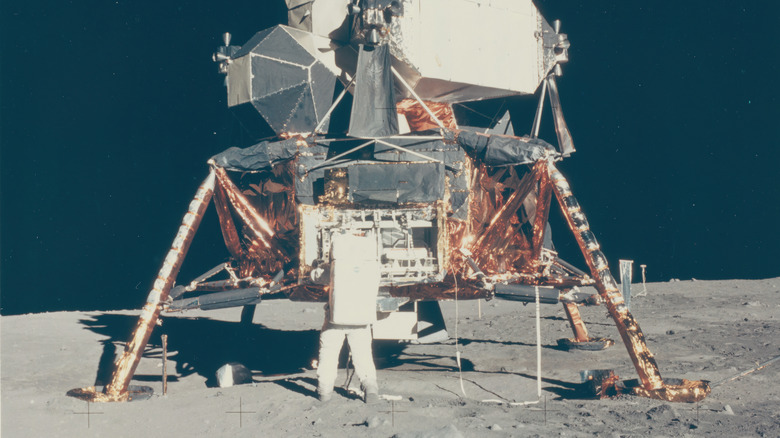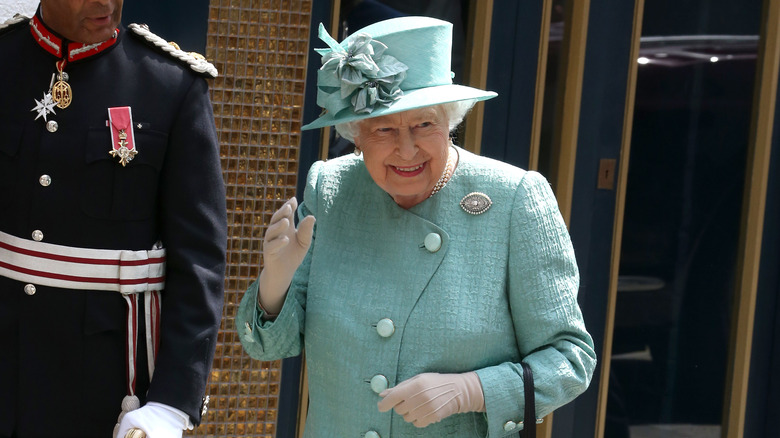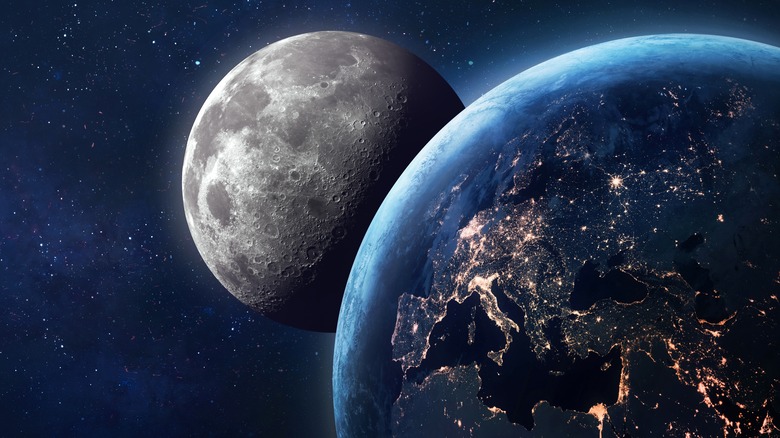The Message Queen Elizabeth II Sent To The Moon - With NASA's Help
Man first landed on the moon in 1969. Astronaut Neil Armstrong was the first person to set foot on the lunar surface, saying the now famous words: "That's one small step for man, one giant leap for mankind," right before he dropped from the landing module. Armstrong was joined by fellow astronaut Buzz Aldrin, and a third man, Michael Collins, who stayed behind in the command module. The other thing that landed on the moon that day was a silicon disk, etched on a microscopic level with goodwill messages written by leaders of many of the world's nations. Among those leaders was the then-monarch of Great Britain, Northern Ireland, and the Commonwealth — Queen Elizabeth II.
The Apollo 11 mission is still one of humanity's greatest achievements. It marked the first time a human has walked on an extra-terrestrial surface. To get there, the astronauts had to not only escape Earth's gravity but also travel close to a quarter of a million miles. A significant chunk of the world's population watched the launch, and the landing itself was broadcast on live television. In addition to the achievement itself, the moon landing had a scientific purpose. The levels and composition of the solar wind hitting the moon were measured, and around 50 pounds of rock and soil samples were gathered. Aldrin and Armstrong spent 21 hours and 38 minutes on the lunar surface before launching back to the command module and making their way back to Earth. Despite the moon being a sterile environment, with no water present, constant unprotected exposure to the sun's radiation, and huge fluctuations in temperature, NASA took the risk. The astronauts were forced to spend three weeks in quarantine in case they had brought any diseases back from the lunar surface (via Brittanica).
What the Queen's moon message said
The Queen's goodwill message, along with quotes from the Pope, several U.S. presidents, and the names of prominent American politicians and NASA staff, were all etched onto a silicon disk. A press release from NASA says that silicon was selected "for its ability to withstand the extreme temperatures of the Moon which range from 250 degrees to minus 280 Fahrenheit." The disk itself was around the size of a 50-cent piece and the etchings on it could only be read by microscope. Despite its ability to withstand a wide range of temperatures, silicon has its downsides. It is incredibly fragile. To help keep it intact, it was placed in an aluminum capsule. That capsule was placed on the lunar surface.
The message from the queen was brief — only two lines long and less than half of what leaders of some other nations wrote — and written in British English. It simply said: "On behalf of the British people I salute the skill and courage which have brought man to the moon. May this endeavour increase the knowledge and well-being of mankind. – Elizabeth R." Queen Elizabeth II died at Balmoral Castle in Scotland on September 8, 2022. She was 96.
We're going back to the moon
Humanity's moon exploration period only lasted a few years. A human hasn't visited the lunar surface since 1972, but that could soon change. As part of their Artemis series of missions, NASA intends to not only visit the moon but also establish a permanent base, similar to the International Space Station, in orbit around Earth's largest satellite. The base will then be used to stage future manned missions further into space, including an eventual mission to Mars. Artemis I, an unmanned test flight, was due to launch in late August. However, delays have pushed the launch date back to late September (via Space.com). The Artemis project isn't just a solo venture from NASA. Numerous private companies, including Elon Musk's SpaceX and Jeff Bezos' Blue Origin, are involved to various degrees. By the time the project is complete and humans are on the moon again, NASA will have spent around $93 billion.
Although it isn't the first mission to the moon, Artemis I will include a few new accomplishments. The most notable of which is the first woman and first person of color going to the moon. The project isn't as simple as a single mission, and several launches are planned between now and 2024 when the moon mission itself will blast off. It is not confirmed if the newly crowned King Charles III will send his own message to the lunar surface during that mission.


